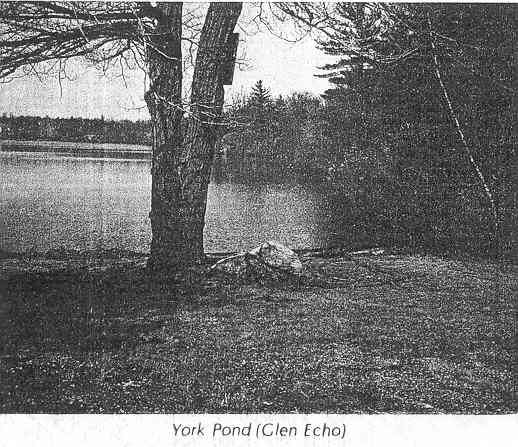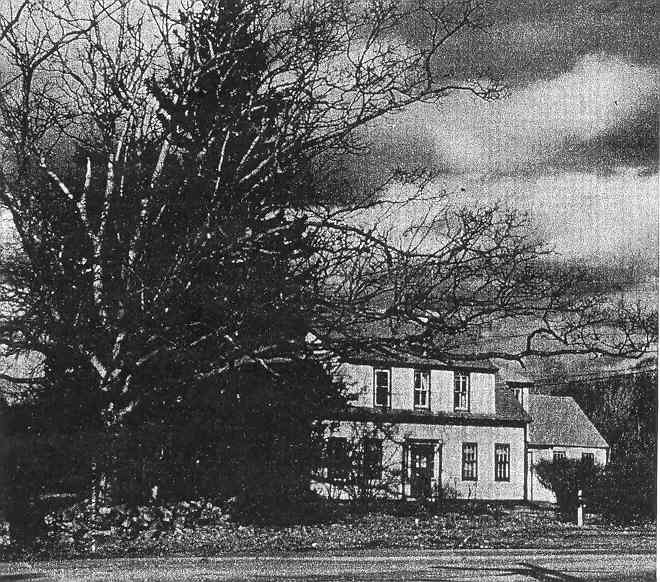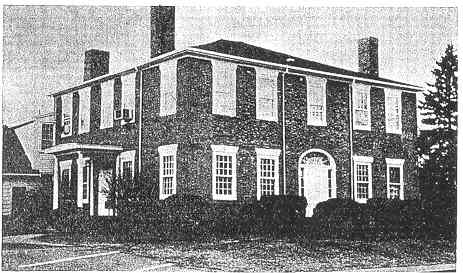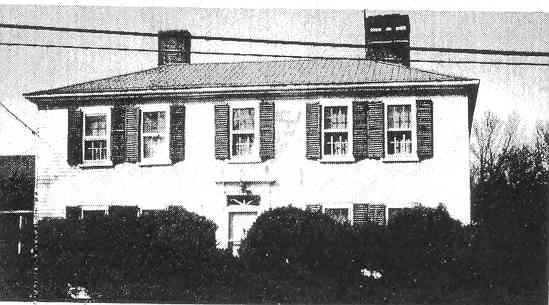
CHAPTER IV
HOTEL NEIGHBORHOOD

York Pond (Glen Echo)
From the Wadsworth houses north on Pleasant Street, Miss Reynolds pictured the area as all farms and woods beyond Lincoln Street to the Edward Capen place on Pine Street', right up until the 20th, century Pleasant Street did not extend beyond Pine Street to Turnpike until 1824 A vast portion of this land between Turnpike, Pine, and Washington Streets belonged to the Capen family from the 1700's, when Jonathan Capen was one of the first nine families to settle Stoughton
On a short street off Pleasant Street toward Central Street, at 280 Lincoln Street, stands a well-preserved colonial house built by John Guild in 1768. The , Historical Society Album states it was built before 1768 by John Guild; the 1929 inventory lists it as standing in 1775; the 1794 map marks it as the J. Guild house, as does the 1831 map. Although there is no further information on J. Guild, there seems little doubt that his house was built in 1768. The grounds are notable also for a magnificent old copper beech tree standing near the street
Between Lincoln and Central Streets, at 301 Pleasant Street, is a house which has been moved and greatly added to, but retains portions of the original Richard Talbot house built in 1805. The Capen collection and News-Sentinel file both give it as 1805, built by Richard Talbot. The 1831 map shows R. Talbot in this location. The Album says it was built in 1805 by a Capen, on the site of a 1782 or older house; it was owned for many years by Mattie Capen, who was born in 1862. Her niece reported that the house belonged before her to her father, George Capen, and it originally stood on a site behind the present one and was moved forward at an unknown date; the kitchen is probably the original house. Although Capens owned it in later years, the Committee accepted Richard Talbot as the original
On the corner of Pleasant and Central Streets, at 434 Pleasant Street, is the other Talbot house, built by Isaac in 1823. Although Miss Reynolds, in her last Site and Survey dated it at 1794, all other data point to 1823. The Capen collection and News-Sentinel file date it 1823, Isaac Talbot owner; the White family, who lived there several generations, confirmed 1823. On the map of 1831, it is definitely marked as I. Talbot's house.

The Reynolds homestead. The Edward Capen house, on land occupied by generations of Capens from the original grant to the
present day. Frank W. Reynolds, the last male of this direct descent, related that the giant oak was said to be a sapling in 1832.
[Historic note (2008): the tree is no longer standing, but the house survives thanks to Friends of the Capen-Reynolds Farm]
The corner of Pleasant and Pine Streets marks the center of the domain of the Capen family, one of the most prominent in Stoughton history. The house at 760 Pleasant Street contains some of the original house built on this site by Edward Capen in 1757. Frank and Bertha Reynolds inherited the homestead from their mother, Mary Capen Reynolds, and carefully researched their genealogy. From Bertha's own summary, the Capens first built near York Pond, then on Pine Street. Their land bordered on the southeast corner of the Ponkapoag Indian Reservation; they acquired much of this North Stoughton land and divided it among many sons,
"Adam Capen (whose name is directly associated with this house) was married in 1816, and had three sons. At his second marriage in 1832, he bought the Edward Capen house and moved from his Pine Street house a mile away. The old house faced on Pine Street which then connected with Old Maple Street. In 1839, Adam built the present house, setting it below a sandy hill over which travel was beginning to go to North Stoughton [present Pleasant Street). He anticipated the hill would be cut down to house level, as it war;. During the building, his family jived in a chamber of the Abner Capers house, 1/4 mile to the east, and the wife cooked for the carpenter's. It has been said that the 'dependency' to the northeast and the cobbler's shop (later also a milk room) were part of the older house. Under this shop, Adam experimented with an invention of an incubator room which failed The warming pipes can still be seen. In this shop, Adam's daughter, Betsey, conducted a private school at age 13."
Ownership of the house passed from Adam to his son Jonathan and daughter Betsey (Bessie) Tillson Capen; then to Jonathan's daughter, Mrs Mary L. B. Capen Reynolds; then to her daughter and son, Bertha and Frank, !t has not been operated as a farm for 50 years. As a footnote, Betsey T. Capen was the founder of chemistry departments at Wellesley and Smith Colleges, and co-founder of the Mary A. Burnham School for Girls in Northampton Until the recent deaths of both Frank and Bertha, this house was in continuous ownership of the Capen family; they generously donated it to the town of Stoughton which they both served so well.
An outlying farmhouse at 387 Page Street was built in 1778 by Mikel (Michael) Henry — spelling was erratic in colonial days, The Capen file and News-Sentinel list both date the house at 1778, with Michael Henry as the original owner. The map of 1794 places a house for Mike! Henry on Page Street here. On the 1831 map, the house is owned by a Bisbee. Beyond the fact that the Town records of marriages state that Michael Henry was married to Beziah Jordan in 1778, there is little information on the Henry family.
Returning to the Hotel down Turnpike Street there are two more Capen homesteads. On a rise from the road stands the dwelling of Wallace Capen, built in 1874, at 769 Turnpike Street. Historian John Flynn established that the first Post Office in Stoughton was opened in this house, "the Wallace Capen place," in 1818, with Aaron Cay as the first Postmaster. Curator John Stiles of the Historical Society has papers which declare the Post Office was set up here in 1814, with Aaron Cay as Postmaster. The Committee therefore accepted the earlier date of 1814 as the original building date. The 1831 map shows a house owned by A. Gay at this site, which suggests he may have purchased it later
The attractive house built in 1824 by Elisha Capen, jr. is located at the intersection of Turnpike and Central Streets, at 719 Turnpike Street. There is an erroneous impression that the first Post Office was here, possibly because of its proximity to the Hotel on the turnpike. A news clipping found in the house about the Capens relates that the house was built near the center of population at that time, near the first Post Office established in August, 1814, and near the Atherton School built opposite Swan Tavern. The "old Tom Swan Tavern" had been built only a few years before. Elmer Capen, who became president of Tufts College, was born here. The Capen collection calls the builder Elisha Capen, jr.; the News-Sentinel calls him Capt. Elisha Capen; both agree the original date was 1824. The 1831 map shows E, Capen here, with A. Cay and a school house beyond. William Capen said the first school in the Atherton neighborhood was built in 1797 in the lower part of the lot at 449 Central .Street and moved to its later position on Turnpike Street in 1827.

The Washington Hotel - Swan Tavern
One of the better known buildings in Stoughton is the stately brick Swan Tavern built at 710 Turnpike Street in 1807. Although several owners have started to research it, it has been difficult to verify certain facts about it. It is known that the South Boston and Taunton Turnpike Corporation was authorized in 1806; William Capen wrote that the "Washington Hotel" (its original name) was built by the Turnpike Corporation in 1809; it was to be a half-way tavern for the users of the turnpike. The corporation ran it until 1817, then sold it to Elisha Swan who ran it for many years as a hotel. He also claimed that "the Government, in its research dept., had made a complete draft in the minutest detail of every part of this ancient building and it will be preserved for the future." A former owner of the building also claimed that the Swan Tavern was the 71st building registered in the Library of Congress, which may be a reference to Capen's information. These documents, however, have not been produced. Lafayette is reported to have visited here on his historic visit to Boston many years after the War.
In Reynolds' 1967 survey it was stated the Tavern was built in 1808; the Old' Colony Historical Council gave it as 1807; the Old Stoughton Musical Society history said sings were held at Capt. Elisha Swan's Hotel, which was built in 1807 and called Washington's Hotel; the News-Sentinel listed the date as 1806; the Capen collection as 1806-7. The 1831 map shows Swan's Hotel. The Committee chose 1807 as the logical date for building this beautiful old Tavern which figured so prominently in the civic and cultural affairs of Stoughton.
Turning the corner at the Tavern and going in the direction of the center of town, there are several fine old houses. Near the corner at 267 Central Street is a Cape style dwelling built in 1800 by Samuel Capen. The 1967 Site and Survey lists the owner as W. Capen, but all other sources give Samuel. The Capen collection and News-Sentinel survey both say Samuel Capen built it in 1800; the News-Sentinel remarks that the 1831 map was used in locating houses built after 1800. The map shows a dwelling for S. Capen between Swan's and a brook near Dickerman's. A local tale relates there was a trapdoor in the floor of its kitchen for hiding runaways on the Underground Railroad, but the owners have no knowledge of this. The house was long known as the Fennel house.
An interesting house stands at 333 Central Street. It was built in 1768 by William Briggs, so far as can be determined The Historical Society Album says that it belonged to Wm. Briggs in 1775, and was standing in 1768; the original owner's name is not given, so it is assumed to be Briggs. The Capen file affirms , Win Briggs in 1768; the News-Sentinel gives him the title Captain Wm. Briggs. Capt. Wm.Briggs marched off to Lexington, along with Jedediah Southworth, The 1794 map shows that Peter Dickerman's house was here on Central Street on a branch of Salisbury Brook. The map of 1831 gives Dickerman at the same location. It has been known as the Wyatt Dickerman farm for many years. There is a spring behind the house whose water was bought in Boston; the long circular drive attests to the report that this was once a way station for changing horses for that haul. There is still rolling farm land around this old homestead.
There is some confusion on the history of the house at 389 Central Street but its owner has researched its deeds back to the early 1800's, and believes they go back to 1790. The Capen collection does not date the house of John Battles at this site; the News-Sentinel states that it was moved from Ames Pond about 1823, which agrees with the information of the owner. The 1794 map does not show Battles here, but there is a J. Battles, Jr. on the 1831 map. The owner states the house is situated on land which was set aside for the first school in the neighborhood The information in the Sentinel seems to corroborate this; it states that the first school house in the Atherton neighborhood (District 5) was built in 1797 in the lower part of the lot at 449 Central Street, and was moved in 1827 to Turnpike Street The moving of a house to this Central Street site and removal of the school seem to coincide. Until further information turns up about the house near Ames Pond, the Committee accepted 1790 as the original date attributed to John Battles' home The spring mentioned, for the previous house is also noted by this owner who declares it has been running for over a hundred years.

Samuel Atherton House. Torn down in June 2005 down to make room for a proposed parking lot.
The last two houses on Central Street belonged to members of the Atherton family from the other end of town At 449 Central Street the elegant home built by Samuel Atherton in 1814 is a splendid example of the early 1800 architecture There seems no doubt as to its date and original owner, both the Capen collection and News-Sentinel list agree on Samuel Atherton, 1814. The map of 1831 squarely places the S, Atherton home here. The relation of Samuel to John, Jr., across the street a short distance, has not been given, but it appears likely he was one of John's sons. It has been said that the same man who built this house in 1814 built the addition to the John Atherton house in 1829, and that the owners were brothers. We can assume that by this time, another son of John, |r. had taken over the homestead (The 1831 map shows "N. Atherton" here.) The house at 449 is being carefully restored by its present owners.
The history of the house at 470 Central Street has been recorded in more detail, perhaps because of the prominence of the original owner. John Atherton, Jr., built the small section of the house to the rear of the present building in 1769. John's father, Deacon John Atherton, was the older brother of Consider Atherton on Pratt's Court, In 1769, John Jr. married Mary Adams, daughter of Stoughton's popular minister. Rev. Jedediah Adams. She must have come to this tiny house as a bride. The Atherton genealogy states John and Mary had nine children. John was a Revolutionary War soldier, and also a Deacon of the Church; he died at the age of 88 in 1835. He and Mary are both buried in the Pearl Street Cemetery, along with several other older members of the Atherton family.
The Album gives John Atherton, Jr. as the owner of this house in 1775; it states that the "e!" was built in 1769, and alterations were made in 1829. This front "alteration" is similar in appearance to the house at 449, but the interiors are different and clearly indicate this one is an addition. The 1794 map shows the John Atherton house; the 1831 map gives the owner as N. Atherton. The Capen file states 1769, built by John Atherton; the News-Sentinel adds that the addition was built in 1829,
In a brochure recently printed by Early American Life, "Colonial Design Book", is a drawing prepared by Frank C. Brown of a fireplace and cupboard in the "Atherton house", Stoughton, 1812. Brown does not state which Atherton house, but the date 1812 infers it is the earlier John Atherton, Jr. home. Until recent years, this lovely old home remained in the Atherton family.
Back to the Table of Contents To the next section...
Back to the main page of www.StoughtonHistory.com